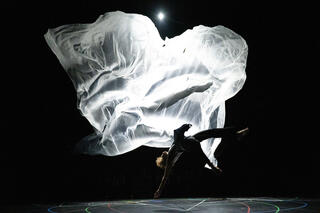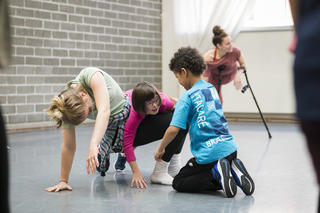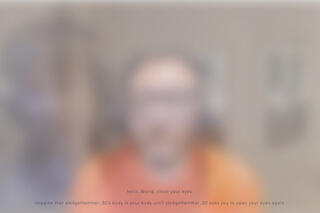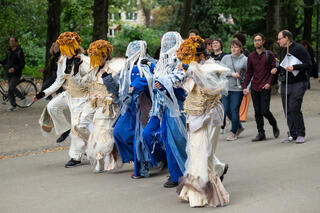Backstage with Anne Teresa De Keersmaeker and Jean-Marie Aerts

In our series "Backstage with..." we regularly feature interviews with people who perform at tanzhaus nrw. The following interview was recorded on 03.01.2023 by dramaturge Wannes Gyselink for Concertgebouw Bruges. Translated from Dutch by Julian Rybarski. Published with the kind permission of Rosas.
When you’re lost, it’s a good idea to retrace your footsteps.
Gyselinck: In Creation 2023, Anne Teresa De Keersmaeker returns to the primary form of human movement – walking – and to the origins of Western pop music: the Blues. She is flanked musically by singer/songwriter Meskerem Mees (1999) and producer/guitarist Jean-Marie Aerts (1951).
Anne Teresa De Keersmaeker: ‘I’ve worked a lot with classical music in recent years, with Bach, of course, and with music from the fourteenth century up to work by contemporary composers such as Grisey and Reich. Music has always been my first partner, and my teacher, also. However, I have also entered into a relationship with pop music at certain times. To most people, pop music is still, in essence, dance music. Pop music also contains many elements that interest me: the pulse that makes you dance, a melody, and a lyrical aspect: it includes text, someone is speaking to you.
Not long ago, I was sorting out my LP collection and stumbled upon a black vinyl record. A note dropped out of its cover that I had never read before, signed: Jean-Marie Aerts. It said: Could you listen to this? Does this music interest you? That was in 1996. I started my career in 1982, and we listened to the music of the Talking Heads and TC Matic at the time. That was the music we danced to in Brussels after work, which was also dancing, but different. The note included only a landline and a fax number. I called it and Jean-Marie answered.
Jean-Marie Aerts: It was quite a shock. I wasn’t expecting that call.
De Keersmaeker: We started talking, about blues, about Robert Johnson, John Lee Hooker, Muddy Waters. I quickly realized that the music I was looking for had to include a voice; pop music is storytelling, and I wanted to tell a story. But it had to be a woman’s voice. I’d seen YouTube videos of Meskerem Mees and thought: yes, that’s real, that’s authentic. So, at a certain moment I asked Jean-Marie if he knew Meskerem Mees.
Yes, he said, you’re right; with her I would love to work.
Aerts: Meskerem stands out. There are a lot of beautiful new female voices at the moment but there is something special about Meskerem.
Meskerem Mees: Thank you.
Aerts: I remember a clip that shows Meskerem singing while Pete Doherty is watching from backstage. You could see he was very impressed.
Mees: He was also very much under the influence at the time. (laughs)
De Keersmaeker: Quite soon after, the three of us started working in Jean-Marie’s studio, starting from the blues but also using beats and BPMs (beats per minute). We developed a structure in which we divided up the different tempos. We quickly turned to Shakespeare for lyrics. Not an obvious combination but it worked. (To Meskerem:) What did you think when I called you?
Mees: I was really happy. Especially when I heard it was about the blues. I grew up with my father’s music: Lead Belly, Mississippi John Hurt, Robert Johnson. I wasn’t so familiar with your work but I was immediately impressed by it.
De Keersmaeker: Originally, the idea was for Meskerem and Jean-Marie to make a kind of soundtrack, and record everything.
Mees: But I wanted to dance too.
De Keersmaeker: Why was that?
Mees: I had the opportunity to tour for two years with my own project, always with the same material. That was great, and I’m very grateful. But in order to make new music one has to be able to step back from the material that is already there, and that isn’t possible while touring. I was missing a challenge – and I know that sounds like a luxury problem. But this – singing and dancing in a Rosas performance – is exactly what I need right now: something I’ve never done before, and that I may not be able to do yet, although I want to give it my all.
De Keersmaeker: On stage Meskerem is accompanied by Carlos Garbin, ex-Rosas dancer and blues guitarist. We juxtapose minimal blues – guitar and voice – with dance-oriented backing tracks. This tension is, I believe, also typical for the history of pop music, which is also the history of the recording of music. There is always a longing for a kind of presence, for what the music sounds like when it is performed live.
Gyselinck: Our first day with all the dancers just ended. How does that feel, Meskerem?
Mees: Very painful at the moment (laughs); I’m literally in pain all over. But I love it: the discipline, the warm-up, then dancing for hours and nothing else. I’m feeling at the moment: I don’t have the body of a trained dancer, but I want to work towards that in the months ahead: to be able to dance for two hours straight without having to deal with painful arms or legs. At the same time, I find it incredibly inspiring to be out of my comfort zone like this. Although I also feel: the relationship between dance and music is very intimate, they are two different ways of dealing with very similar impulses. The difference is that dancing makes one focus entirely on one’s own body, or, in any case, takes one out of one’s head. That’s wonderful.
Gyselinck: Jean-Marie, how did Robert Johnson and the blues cross the path of a boy from Zeebrugge?
Aerts: In Zeebrugge, England was very close. Just hop on the ferry and a few hours later we were in a record shop in London, browsing the vinyl. We were constantly going back and forth and we brought back records by The Cream, with Eric Clapton, and the blues of John Mayall and Peter Green. They played electric blues, and made the blues popular again – it became ‘pop’ music. When one starts digging into their influences, one automatically arrives at the American blues artists: Robert Johnson who was actually one of the last of a generation, commanded a lot of different styles, and was also one of the first to record. I started to see Robert Johnson as a kind of musical precursor. In my studio, I work between two posters: one of Billie Holiday and one of Robert Johnson. My two guardian angels. To stop me from messing up when making music. They keep me on the right track, they make sure that what I do is authentic, that it’s real, and that it’s enjoyable too. But Robert Johnson led a very different life to my own: more dangerous and shorter too. He was a ladies’ man; that’s clear in the photographs, with his suit and his guitar. He was poisoned by a jealous husband.
Gyselinck: Anne Teresa, what is that makes blues a good starting point for a dance performance?
De Keersmaeker: I started out with minimalism in 1982, the music of Steve Reich, the minimalist beats of Rosas danst Rosas. Evolutions are often circular with me: less is more, I increasingly think, back to the source, to the real thing. Stripping off the packaging and the frills, making the most of the capacities of the human body (stamps her feet, whistles), of what the voice can do. That’s also where my fascination with the blues lies: the old blues artists played without amplification, they stamped out the rhythm on wooden floors, and they sang and played loud – they howled – to be louder than the people dancing.
Aerts: And they used claves to make elementary beats. The slaves had to hammer beams together with a kind of wooden cylinders called claves. They took them home with them and created rhythms with them, which were also very important in the music of the Caribbean. First and foremost, the blues is the music of black slaves who found freedom in their own music.
De Keersmaeker: Blues is about sorrow and joy, my sorrow, my joy but also our sorrow, our joy. Both individual and collective: that tension is crucial to me. Blues is also alchemy: we sing about our sadness, but by singing about it with others we transform it into a strength, something joyful. That’s the source of the blues, and pop, maybe even all art. If you can’t say it, sing it. If you can’t sing it, dance it. But I don’t want to get nostalgic: the history of pop music is also the history of technology, music production, recording, ‘adding fire’: amplification, manipulating sound, capturing sound.
Gyselinck: The tension between musical simplicity and technology is what you are looking for.
De Keersmaeker: I don’t dismiss technology. It’s no coincidence that I’m sitting here between Jean-Marie and Meskerem, a master producer and someone with a voice that is very penetrating even without amplification. I want to play the two off each other, to ask the question: what is our relationship with technology, with science, what are our tools in order to make that party, that reflection, that song of consolation happen? Particularly considering the ecological crisis which also arises from our use of technology.
Gyselinck: You work with a group of twelve young dancers, and Meskerem, who is also young.
De Keersmaeker: Polarity is everything. I often work with older dancers, and often with younger dancers. I also like a blend of old and young – for example, Meskerem and Jean-Marie. I also like a larger group where that interplay between the individual and the collective happens automatically. I am very attached to those relationships: it’s wonderful to dance alone and also wonderful to dance a duet. As soon as you dance as a trio there is rivalry, territory, changing alliances, and counterpoint. But the party is with everybody. Then the circle is whole – maybe a broken circle, a semicircle including the audience. Whether it’s a string quartet, a symphonic orchestra or a group of dancers: a semicircle is always an invitation to the audience to complete the circle, to move together. Isn’t this ultimately why we make art? To mourn together and to celebrate joy together. Beauty and solace. Art, and especially music and dance, have a healing power. That goes all the way back to Apollo: the god of both music and medicine.
I know it, and Lucebert said it: in these times, beauty has burned her face, everything of value is defenceless. I’m still willing to do that: to bet on beauty. In the case of Bach, beauty is harmony. It comes from a Greek word that actually means ‘that which works together’ - like the mechanism of a door handle, a horse’s bridle, the joint in one’s shoulder. In itself that has nothing to do with aesthetic trappings. I know that beauty is considered to be old-fashioned, but we need it more than ever: our relationship with nature is disturbed, we see ourselves outside of it but we are in the middle of it, we’re part of it together with plants, animals, natural resources, air and water. We’ve lost that harmony. Maybe that’s why I’m now working with young dancers, people who are young now, at this turning point. For me, dance is also ‘working together’ across generations. That is very rewarding. This was the case for the farmers of the past too: we need the passion and strength of the younger generations, and their desire for adventure. But there is also the older farmer who says “now is not the time to harvest, it’s too soon.” That back-and-forth between generations, the transfer of knowledge is what we need. L’union fait la force; let’s focus on what we share, what we can give each other and teach each other.




